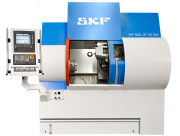 SKF has perfected the latest version of SKF SEAL JET, its proprietary method of producing seals by machining soft materials such as rubber and polyurethane. The technique allows seals to be machined quickly and easily – for use as either product development prototypes or as low-volume replacement products. Seals made using SKF SEAL JET are identical in dimensions and properties to those made using mass production techniques like injection moulding.
SKF has perfected the latest version of SKF SEAL JET, its proprietary method of producing seals by machining soft materials such as rubber and polyurethane. The technique allows seals to be machined quickly and easily – for use as either product development prototypes or as low-volume replacement products. Seals made using SKF SEAL JET are identical in dimensions and properties to those made using mass production techniques like injection moulding.
“Customers need fully functional prototypes that can be tested under real conditions,” says Thomas Schwarz, director of Fluid System Seals at SKF. “Seals made using SKF SEAL JET can withstand full ‘in-field’ testing.”
SKF SEAL JET was originally developed as a way of providing replacement seals at short notice, but its speed and flexibility has made it invaluable as a prototyping tool in product development. It is typically used to prototype dynamic hydraulic seals for applications such as rod and piston seals, for industries including off-highway, cylinder manufacturing, machine tools and food.
Even today, many prototype seals are still made using prototype moulds. This process can be costly and time-consuming, as four or five mould iterations are usually needed before the seal is perfected. SKF SEAL JET is much faster, because prototype seals can quickly be machined to exact dimensions.
Several underlying technologies are fundamental to SKF SEAL JET’s success. The most important is the ability to machine the soft materials used for seals, such as polyurethane, rubber and even PTFE and PEEK. It does this through a combination of special cutting blade design, careful process control and a proprietary ‘chip removal’ system.
“Machining chips are highly elastic, and can damage the tools. Removing the chips is vitally important,” says Schwarz.
At the same time, SKF has developed its own wide range of material grades, allowing it to produce seals with a broad range of properties. These must be able to deliver important characteristics of a seal, such as surface roughness.
The process is typically used to make seals up to 600mm outside diameter, but it can make very small and very large products – with the largest up to 4 000mm in diameter, as one piece and even larger using a special welding technique. Its flexibility means that it can also produce seals in non-standard sizes.
While 3D printing techniques such as selective laser sintering (SLS) and fused deposition modelling (FDM) have made huge advances in prototyping, they are unlikely to find their way into seal development. This is partly because the range of available materials is too narrow, but also, seal prototypes must be of equivalent quality to the finished product, capable of withstanding ‘field’ testing. Seals made using 3D printing techniques will not have sufficiently robust physical characteristics.


